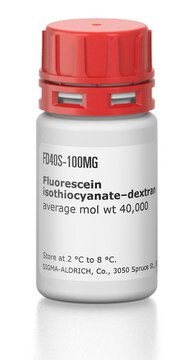SCC469
MOC1 Mouse Oral Squamous Cell Carcinoma (OSCC) Cell Line
Mouse
Sinónimos:
MOC2 cell line, mouse oral carcinoma 2 cell line, oral carcinoma cell line
About This Item
Productos recomendados
product name
MOC1 Mouse Oral Squamous Cell Carcinoma (OSCC) Cell Line,
origen biológico
mouse
Nivel de calidad
envase
vial of ≥1X10⁶ cells/vial vials
fabricante / nombre comercial
Millipore
técnicas
cell culture | mammalian: suitable
Condiciones de envío
liquid nitrogen
temp. de almacenamiento
−196°C
Aplicación
- Each vial contains >1X106 viable cells.
- MOC1 cells are verified to be of mouse origin and negative for human, rat, Chinese hamster, Golden Syrian hamster, and non-human primate interspecies contamination, as assessed by a Contamination Clear panel by Charles River Animal Diagnostic Services
- Cells tested negative for infectious diseases against a Mouse Essential CLEAR panel by Charles River Animal Diagnostic Services.
- Cells tested negative for mycoplasma.
Características y beneficios
Descripción de destino
Almacenamiento y estabilidad
Cláusula de descargo de responsabilidad
Código de clase de almacenamiento
10 - Combustible liquids
Clase de riesgo para el agua (WGK)
WGK 3
Punto de inflamabilidad (°F)
Not applicable
Punto de inflamabilidad (°C)
Not applicable
Certificados de análisis (COA)
Busque Certificados de análisis (COA) introduciendo el número de lote del producto. Los números de lote se encuentran en la etiqueta del producto después de las palabras «Lot» o «Batch»
¿Ya tiene este producto?
Encuentre la documentación para los productos que ha comprado recientemente en la Biblioteca de documentos.
Nuestro equipo de científicos tiene experiencia en todas las áreas de investigación: Ciencias de la vida, Ciencia de los materiales, Síntesis química, Cromatografía, Analítica y muchas otras.
Póngase en contacto con el Servicio técnico






